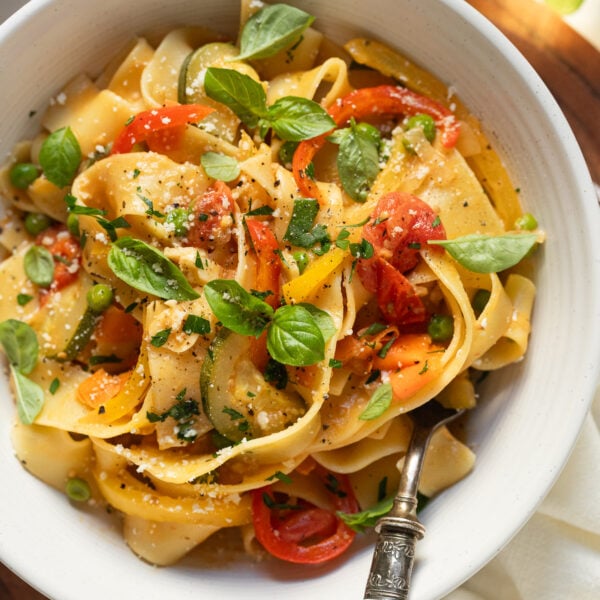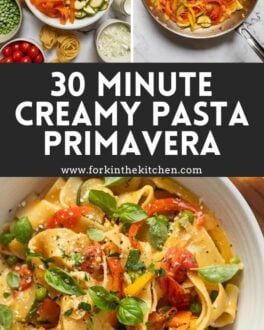When it comes to favorites, I’m hard-pressed to pick just *one* – especially when we’re talking vegetarian pasta recipes.
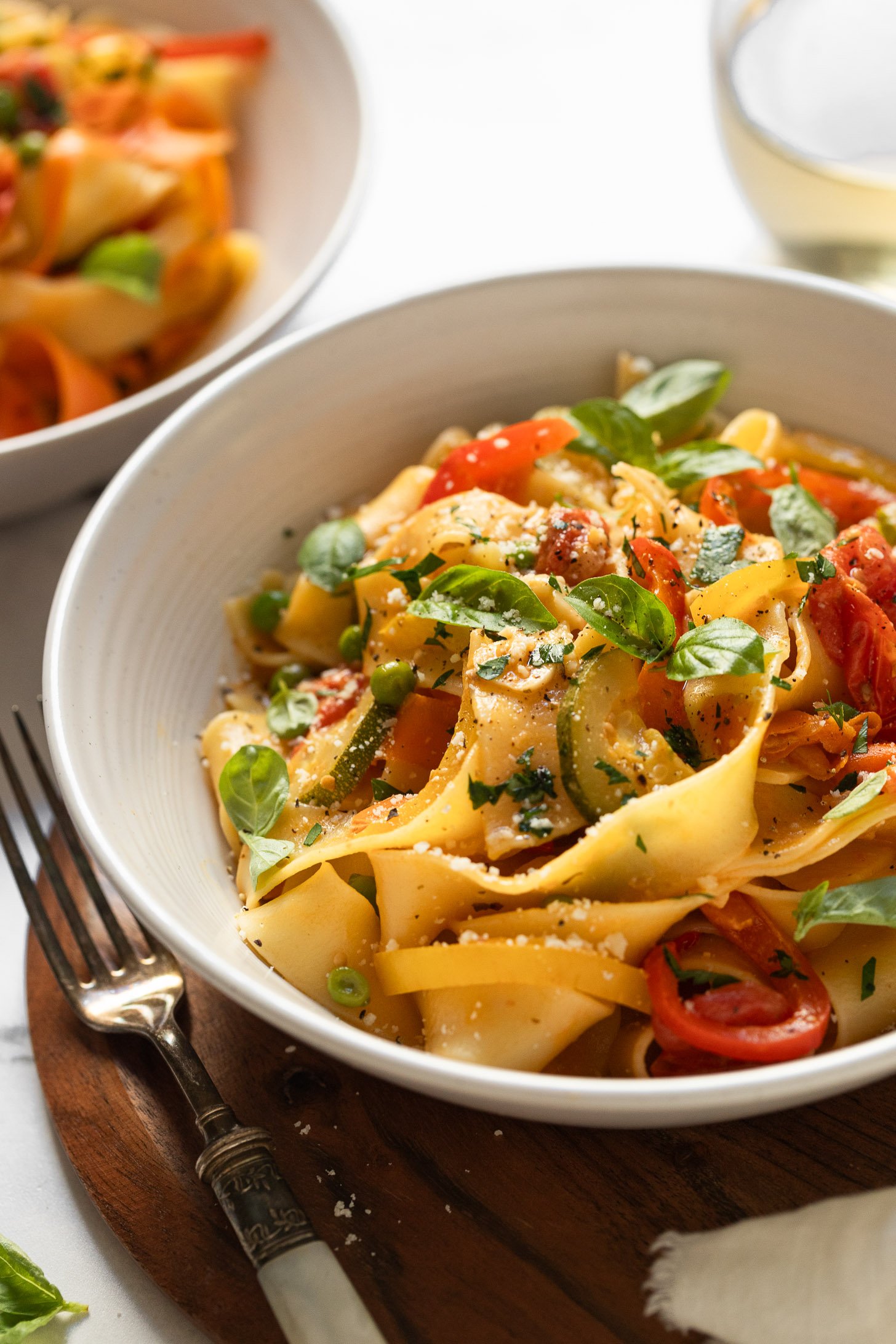
If you don’t tell the others, then I’ll admit that this one is right up there. With the flavorful light cream sauce paired with fresh vegetables and those carrot ribbons, it’s truly an unbeatable dinner.
Even better? You get all your veggies in WITH your carbs, and that, my friend, is how I like to do it. If you’re the same, let’s get cooking!
What is Pasta Primavera?
Pasta Primavera translates to “spring pasta” in Italian, but it’s technically an American dish that was invented in New York City in the 1970s. It’s quite an interesting story if you want to read about it. The dish is essentially pasta in a cream sauce with fresh vegetables.
Because it translates to “spring pasta” you’ll often find a lot of spring vegetables in the dish. In this recipe, you’ll find a blend of vegetables that are easy to find year-round in the United States, however, feel free to substitute. More on that coming right up…
Ingredient Spotlight
As I mentioned, there’s a mix of veggies in this recipe in that you should be able to easily find year-round. However, it’s quite simple to change the veggies depending on season, or what you have on hand.
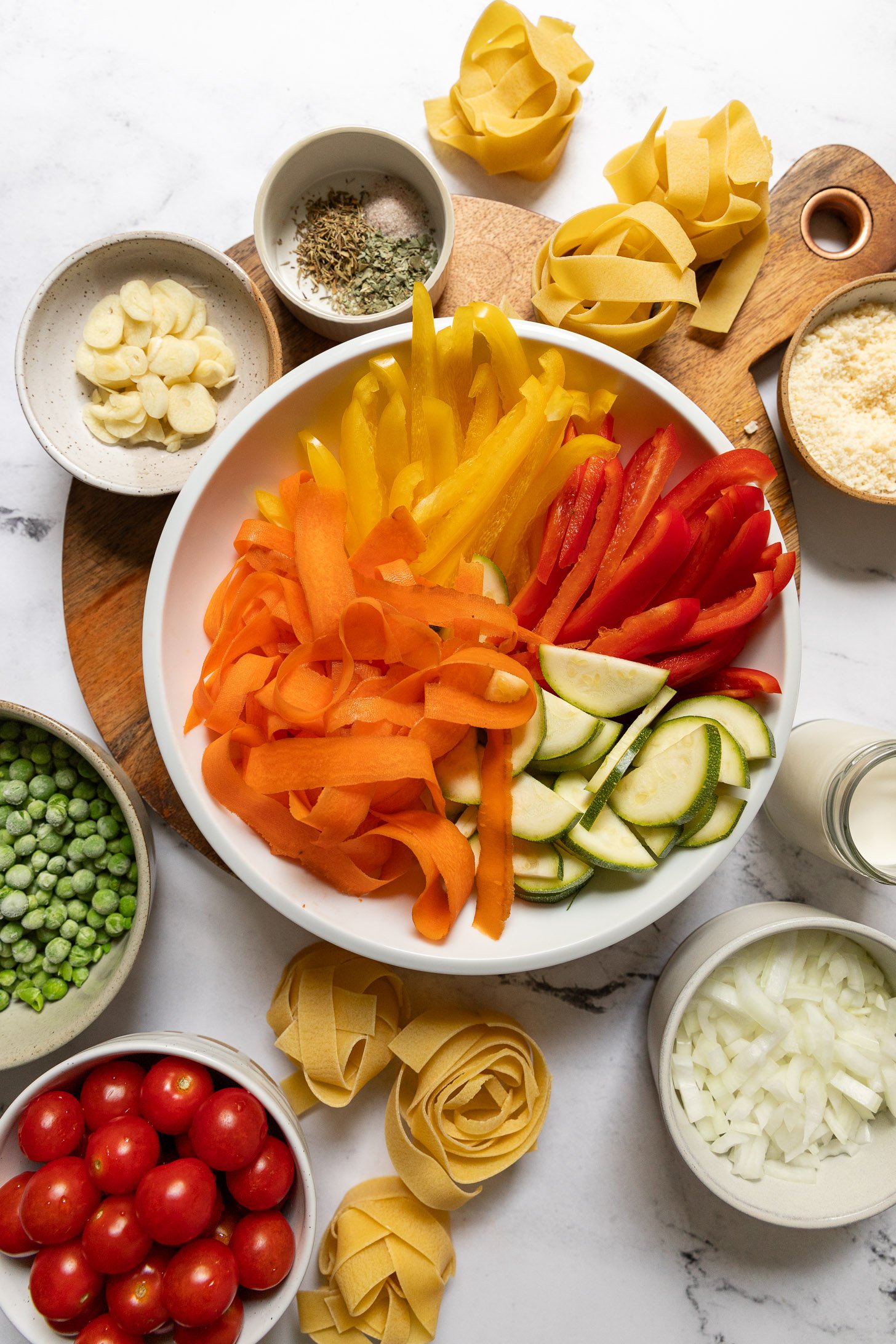
In spring, I like to focus on more veggies like fresh asparagus, yellow squash, and peas. For a heartier fall recipe, I substitute mushrooms and broccoli. There are so many variations to try!
Please be sure to see the full recipe card below for amounts.
- Pappardelle Pasta – large, broad, flat pasta that’s similar to fettuccine or tagliatelle, with straight sides. I love these wide noodles for pasta primavera but feel free to substitute with a smaller noodle like penne, fusilli, or farfalle.
- Yellow Onion and Garlic – both aromatics, add a ton of flavor to the pasta! I’ve tested this recipe with both sliced and minced garlic, and I personally preferred the flavor that is more infused when minced. For a milder garlic flavor, try thinly sliced.
- Bell Peppers – any color combination you like, we’ll use two for this recipe.
- Cherry Tomatoes – similar to our blistered tomato sauce, they are added whole and cook down, bursting with their juices into the sauce. If you have whole tomatoes, simply dice and add them.
- Whole Carrots – get ribboned using a vegetable peeler. The thin sheets work their way through the pasta adding a wonderful texture!
- Zucchini – cut into half moons, they blend into the pasta and add nutrients.
- Frozen Peas – optional, but I like the burst of color they add to the pasta.
- Fresh Basil – a few dried herbs go into the pasta for added flavor, but finishing with fresh basil really takes this pasta to the next level. I do say this is…not so optional.
- Half and Half – just 1/2 cup goes into the sauce to give it a little richness but it’s balanced out with vegetable stock, keeping it light. Use heavy cream for an even more luxurious sauce.
- Parmesan Cheese – strict vegetarians should be sure to use a brand that is labeled vegetarian or made with microbial enzymes.
Other Veggie Options
- Wilt in greens at the end of the cooking process – kale, spinach, or arugula are excellent options.
- I’ve tested this with diced eggplant in place of the zucchini, but I added it with the red bell pepper. It almost melted into the sauce, but was lovely.
- Mushrooms add a hearty addition, I’d recommend sauteing them first in a dry pan, as we do with mushroom spinach pasta, to ensure the water is evaporated and they have room to absorb the flavor. Otherwise, add them with the onions.
- When in season, chopped asparagus or green beans are lovely! Add with the red bell peppers.
- More cruciferous vegetables – broccoli and cauliflower pieces can both be added towards the beginning of the saute process so they have time to cook.
How to Make Pasta Primavera
This is a pretty easy pasta recipe to make, just requiring sauteeing of veggies to create the sauce, and boiling the water.
You’ll start sauteing finely chopped yellow onion – this is the first step in building flavor. Once the onion starts to become tender, add the bell peppers, garlic, and tomatoes.
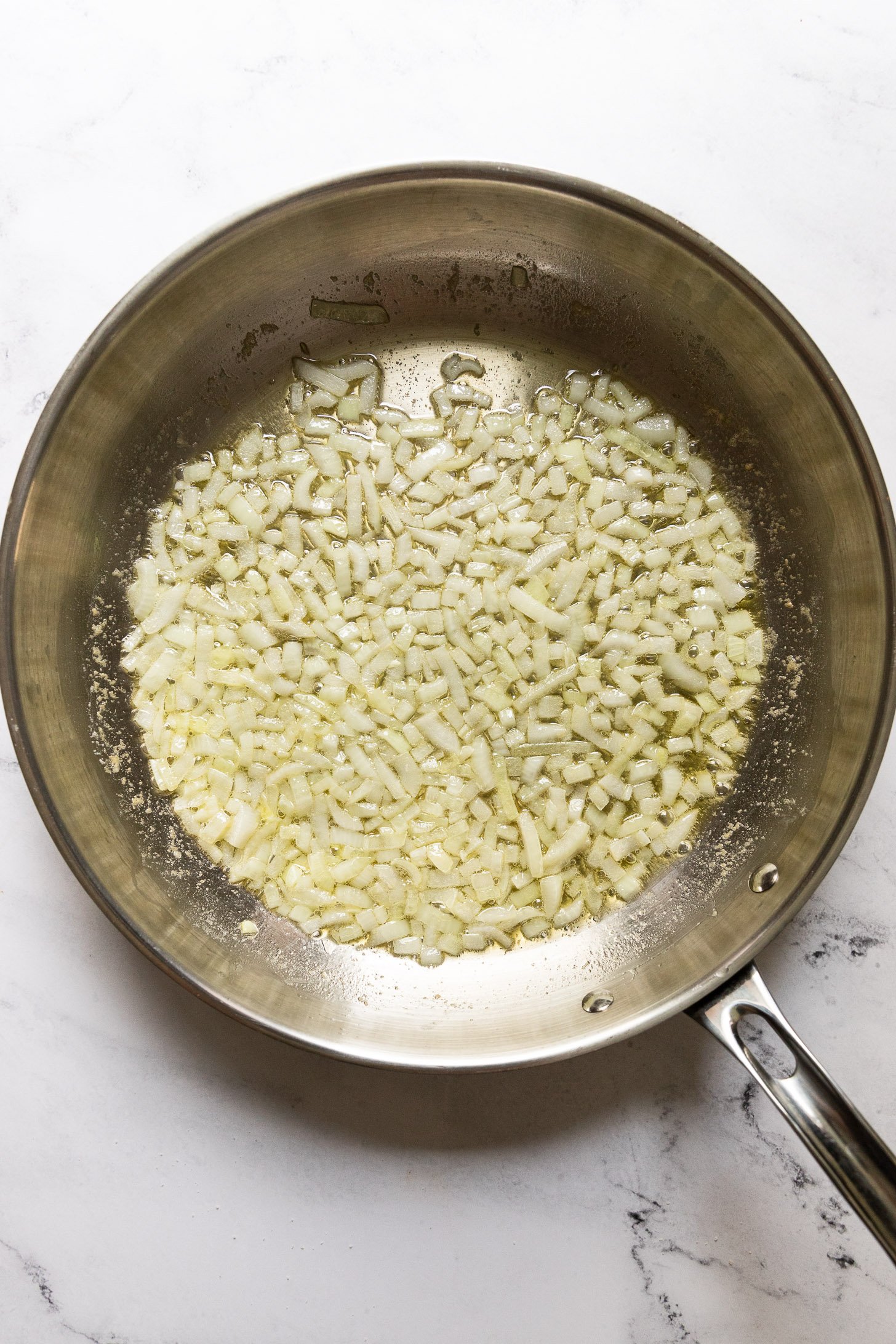
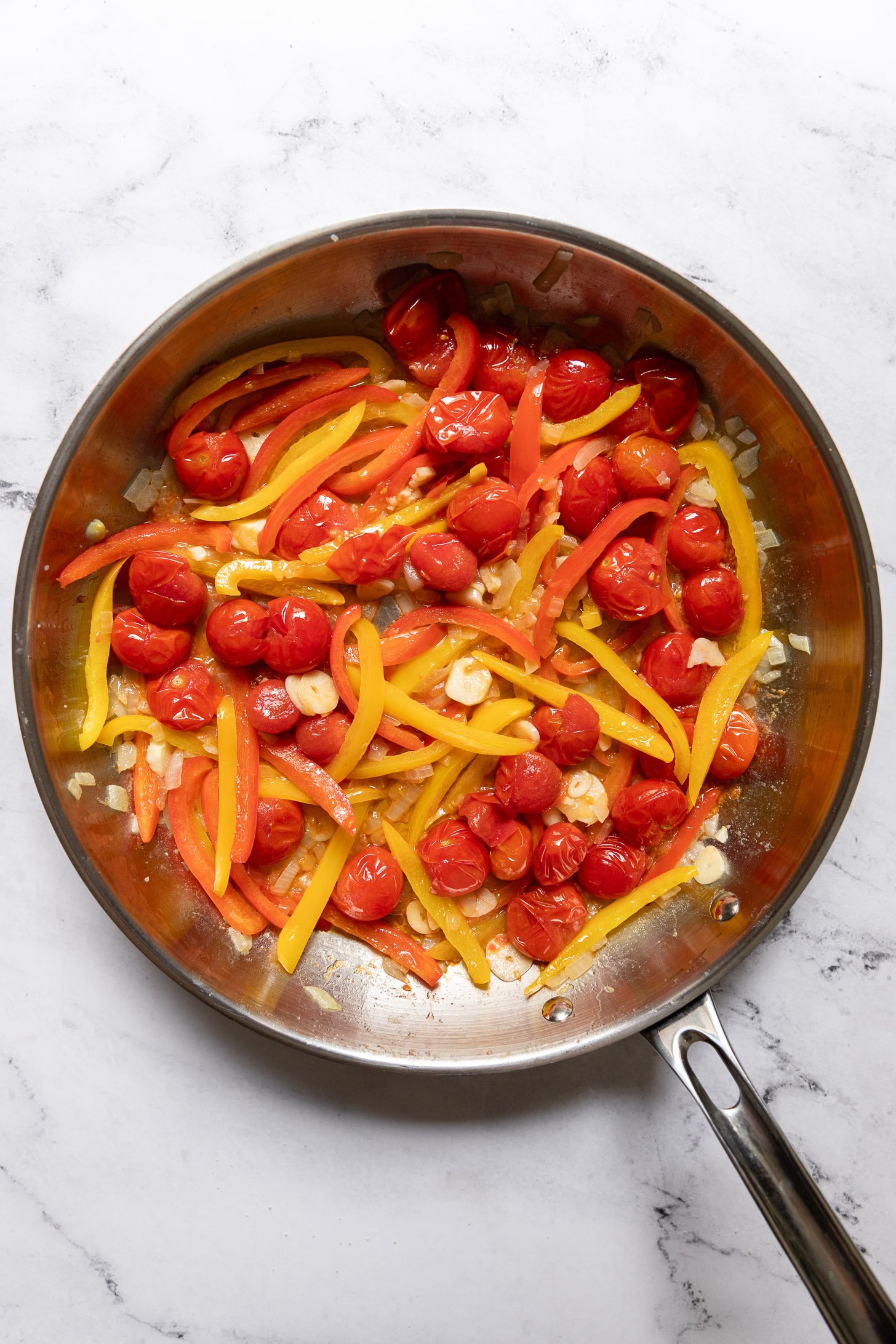
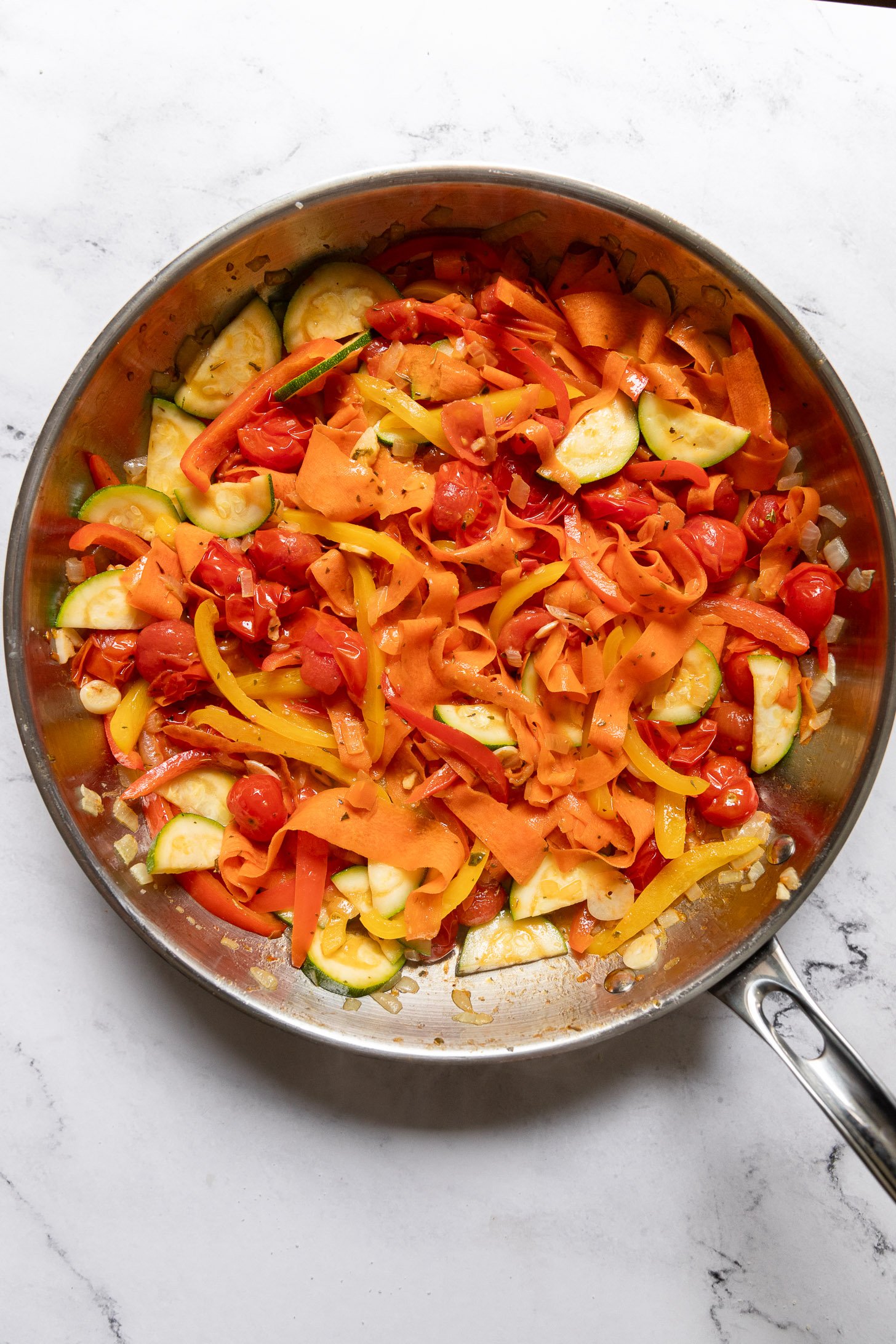
Cherry tomatoes are added whole and as they soften and cook, they become blistered. When this happens, they’re easy to burst with the back of the spoon, releasing their juices. This is one of my favorite techniques for a light tomato sauce that I use in our highly-rated tomato gnocchi recipe.
Add salt throughout the cooking process, continuing to taste test – especially towards the end – to make sure the sauce is balanced and is salted properly.
After they’ve blistered and “popped”, the zucchini and carrot ribbons get tossed in for a quick saute before the sauce ingredients are added. This gives them time to infuse the flavor, without overcooking.
If you are using thicker julienned carrots, rounds, or diced, add them with the red bell pepper so they have time to soften.
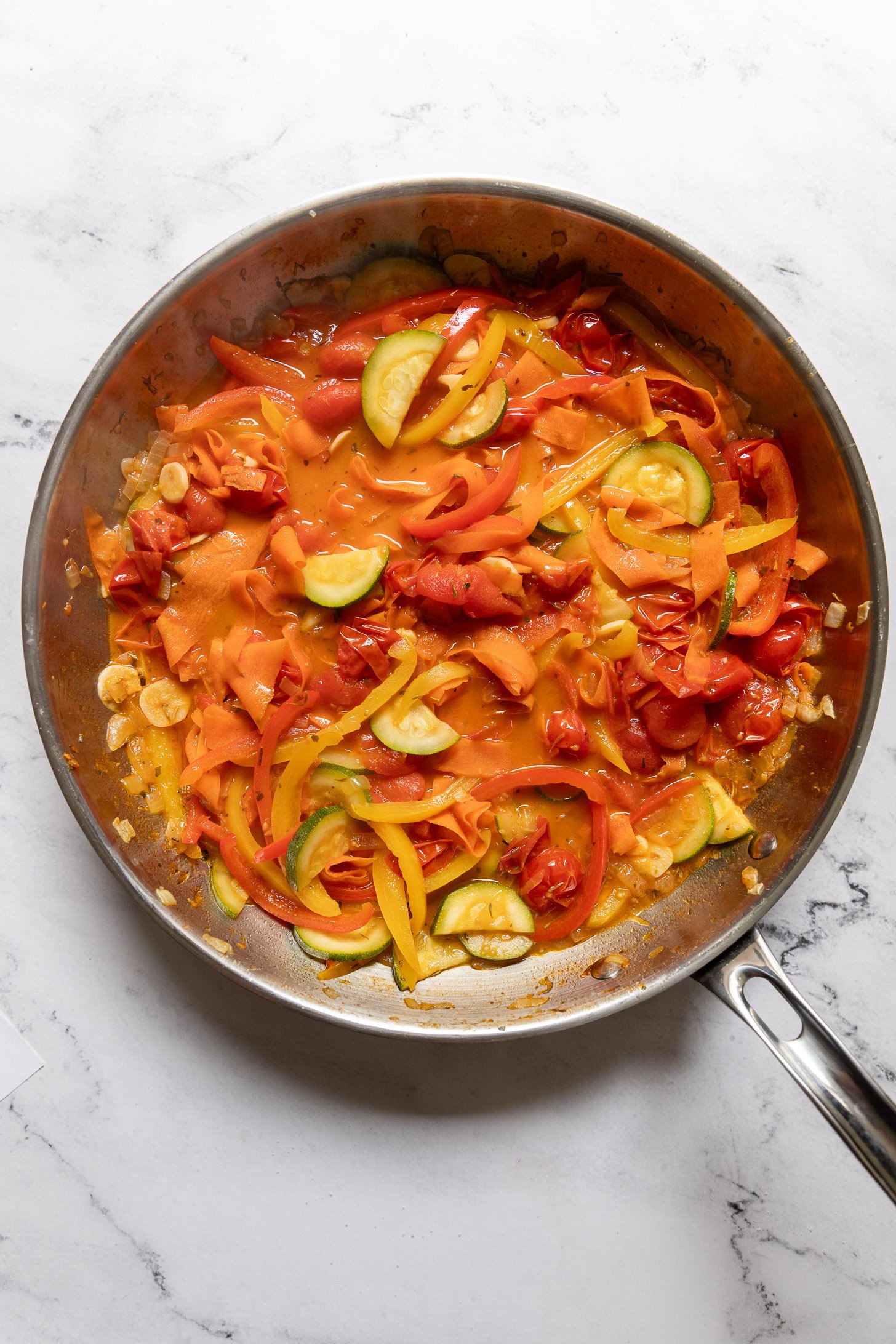
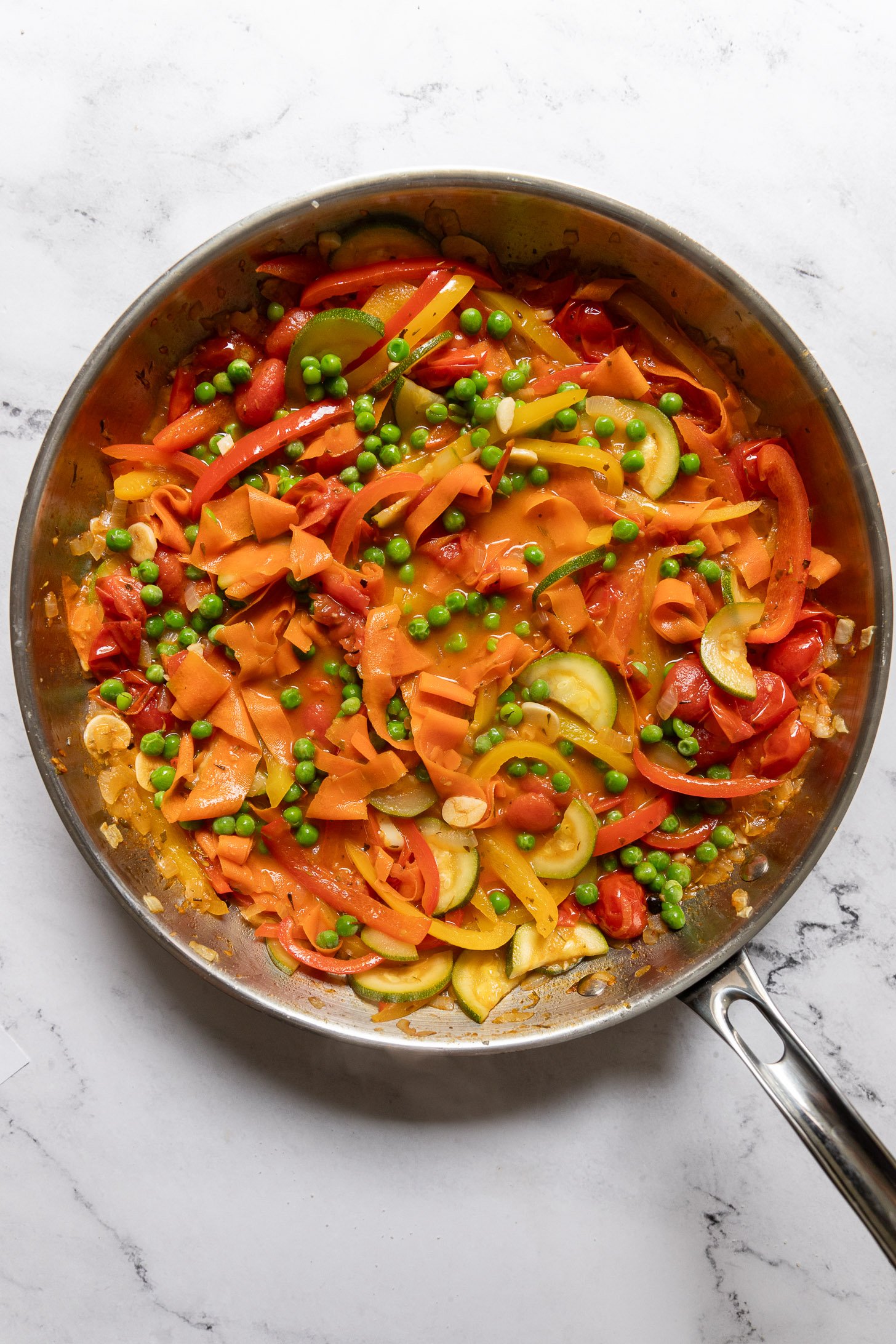
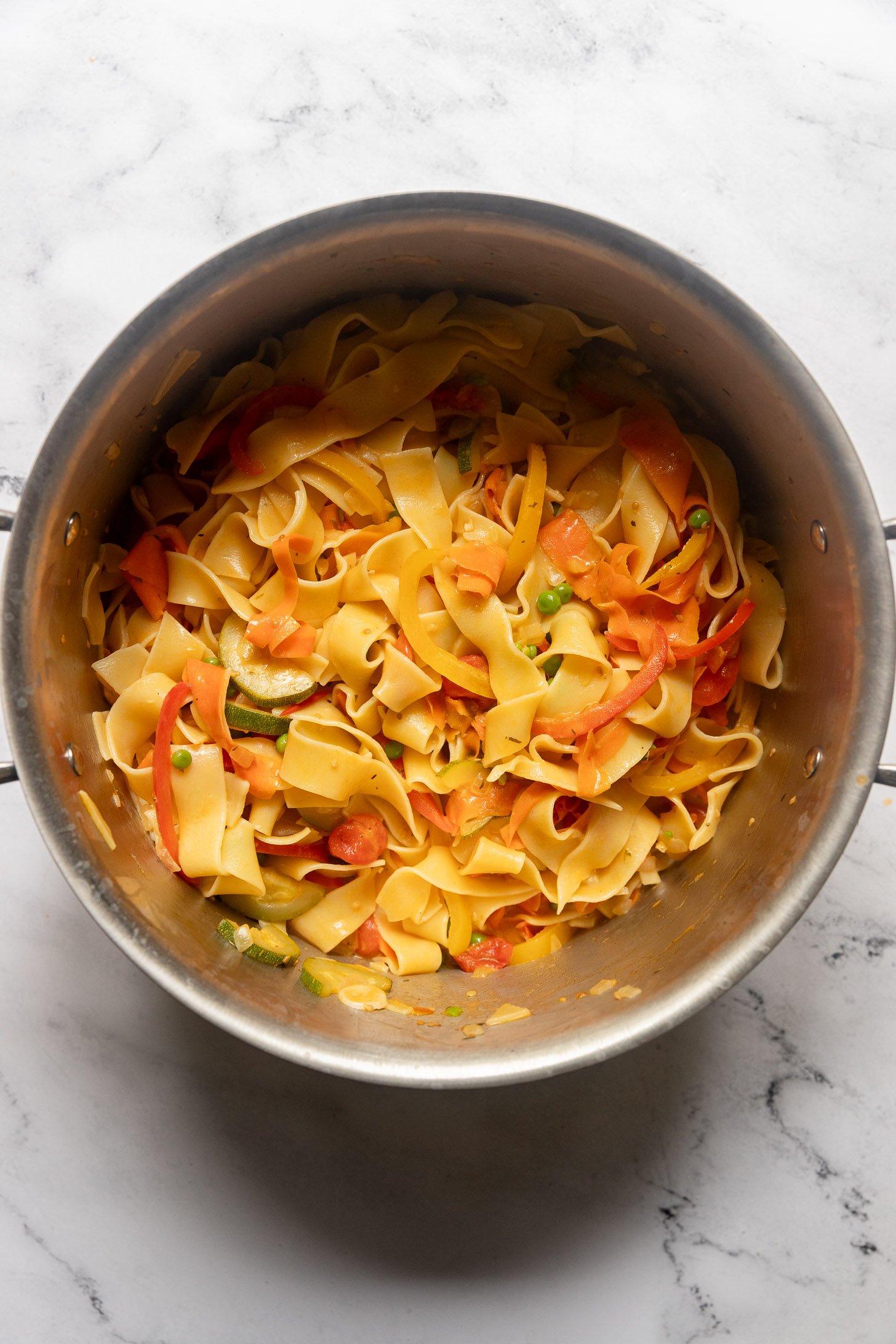
Deglazing the pan with white wine adds a beautiful flavor to this pasta primavera sauce, so if you have wine on hand (or are enjoying a glass) consider pouring a splash in. Otherwise, deglaze the pan with a little vegetable stock before adding the remaining amount.
Deglazing the pan gives the sauce a flavorful start, allowing for any stuck-on bits to get incorporated into the sauce, and helps the flavors reduce before continuing.
Add vegetable stock and let it simmer down while the pasta cooks. Before serving, add half-and-half and parmesan cheese, along with frozen peas if using.
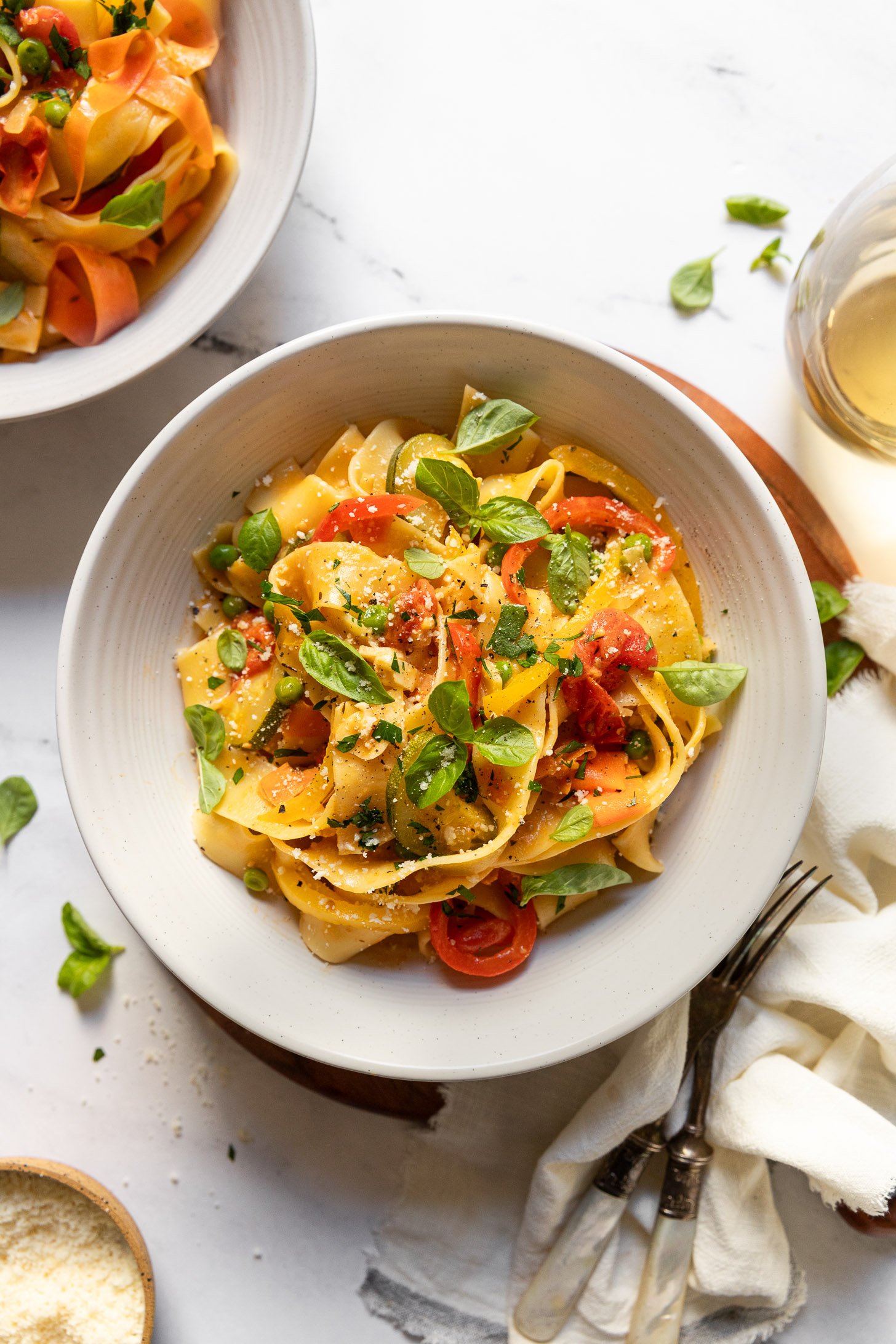
Let’s Eat!
Before serving, garnish or toss in fresh basil leaves. Honestly, this is a game-changer and a step that should be taken seriously. Do I ever mess around with basil though?
Anyway, this fresh herb adds brightness and brings out the rich veggie flavor in the sauce, complementing the pasta so beautifully.
Because this pasta dish is heavy on the veggies, it can totally be a complete meal in itself. For seafood lovers, you could add shrimp, and for meat eaters, chicken would be a good option.
Otherwise, roasted broccolini pairs nicely with the flavors as a side dish. Or, serve it with a light green salad with white balsamic vinaigrette.
And of course, it goes lovely with a bright, crisp glass of white wine.
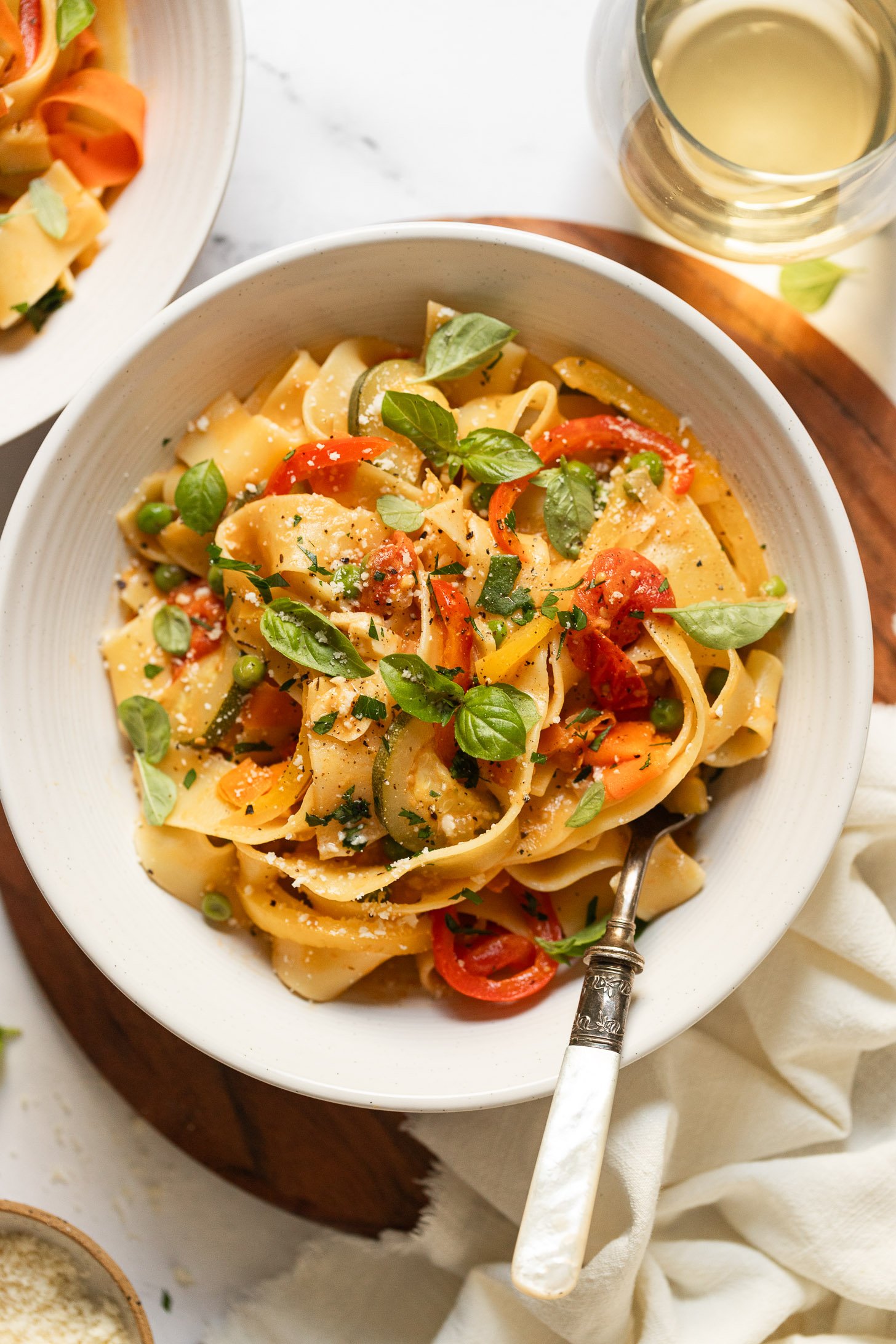
Storage Tips and Reheating
This is a pasta recipe that I don’t mind reheating and enjoying the leftovers. They hold up pretty well!
Store any leftover pasta in an airtight container in the fridge. If you have any leftover reserved pasta water, consider pouring a tablespoon or two in with the pasta; this will help reconstitute the sauce when reheated.
You can also add a little cream when you are reheating the pasta to help the sauce stay…saucy.
Reheat in the microwave or on the stovetop until heated through. Enjoy with extra fresh basil and some extra parmesan cheese.
Did you make this recipe? Please leave a star rating and review in the form below. I appreciate your feedback, and it helps others, too!
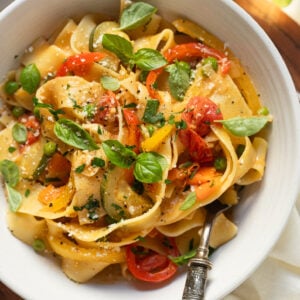
Get the Recipe Creamy 30-Minute Vegetable Pasta Primavera
Ingredients
- 16 ounces dried pappardelle pasta, or fettuccine
- 3 Tablespoons unsalted butter
- 2 Tablespoons extra virgin olive oil
- 1 cup yellow onion, diced
- 2 bell peppers, thinly sliced
- 1 dry pint cherry tomatoes
- 3-4 cloves garlic, minced or thinly sliced*
- 1 teaspoon dried basil
- ½ teaspoon dried thyme
- ½ teaspoon dried oregano
- ⅛-¼ teaspoon red pepper flakes
- Fine sea salt, to taste
- Freshly ground black pepper, to taste
- 2 cups carrots, ribboned with vegetable peeler – about 2 carrots
- 1 cup zucchini, thinly sliced and cut into half moons
- ¼ cup white wine or vegetable stock
- 1 ¼ cup vegetable stock
- 1 cup frozen peas, optional
- ½ cup half and half
- ¼ cup grated parmesan cheese
- ¼ – ½ cup reserved pasta water
- ¼ cup fresh basil leaves, for serving
- Squeeze fresh lemon juice, optional
Equipment
Instructions
- Heat a large stockpot of salted water over medium-high heat. It's helpful to start this first so by the time we need it, it's at a boil.
- In a large skillet over medium to medium-high heat, melt the butter and heat the oil. Add the onion and saute for 3-4 minutes. Add a pinch of salt.3 Tablespoons unsalted butter, 2 Tablespoons extra virgin olive oil, 1 cup yellow onion
- Add the sliced bell peppers, whole cherry tomatoes, garlic, dried herbs, and red pepper flakes. Stir to combine and cook for about 4-5 minutes. As the tomatoes blister and soften, gently smash them with the back of a spoon to burst, allowing the juices to simmer.2 bell peppers, 1 dry pint cherry tomatoes, 3-4 cloves garlic, 1 teaspoon dried basil, ½ teaspoon dried thyme, ⅛-¼ teaspoon red pepper flakes, Fine sea salt, Freshly ground black pepper
- Add the carrot ribbons and zucchini to the skillet, cooking for 1-2 minutes. Deglaze the pan with white wine or stock, scraping up any bits as needed.2 cups carrots, 1 cup zucchini, ¼ cup white wine or vegetable stock
- Add the remaining vegetable stock to the skillet and bring to a simmer. Allow it to simmer and reduce for about 6-7 minutes, taste testing it as it cooks and adding salt and pepper as needed.1 ¼ cup vegetable stock
- By this point, the water for the pasta should be boiling, add it to the pan and cook for about 1 minute less than the al dente package directions. Reserve about 1 cup of pasta water before draining.16 ounces dried pappardelle pasta
- When the sauce has reduced after about 6-7 minutes, stir in the frozen peas, half and half, and parmesan cheese until combined. Drain the pasta – don't forget to reserve some water – and toss it with the sauce. Depending on the size of your skillet, you may want to transfer the sauce to the big pot to toss instead.1 cup frozen peas, ½ cup half and half, ¼ cup grated parmesan cheese
- Add approximately 1/4 cup pasta water to start. You likely won't need much, but a little helps the sauce adhere. The sauce will continue to thicken as it cools slightly. Cook the pasta in the sauce for about 1 minute until al dente.¼ – ½ cup reserved pasta water
- Remove from heat and serve with fresh basil. If desired, add a squeeze of fresh lemon juice for brightness.¼ cup fresh basil leaves
Notes
- 4-6 servings, depending on appetites
- Garlic: for a more prominent garlic flavor, mince it; thinly slice the cloves for a milder flavor throughout.

